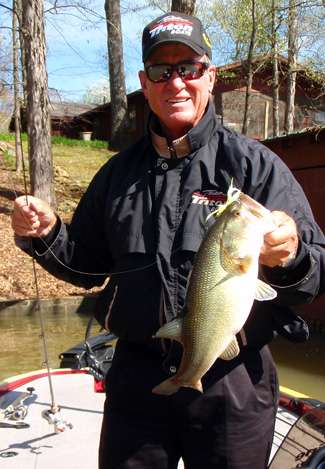
DECATUR, Ala. — One of the new features of the Elite Series this year is employing marshals to accompany pros as non-fishing observers. At the Evan Williams Bourbon Dixie Duel on Lake Wheeler, Ala., we asked two marshals, Chris Pope of Pensacola, Fla., and Wendell Johnston of Belfast, Tenn., to keep journals of their day on the water. In Round Two, they rode with Guy Eaker and John Murray, respectively Pope, as it happened:As expected, the weather was sunny and the lake was slick when we left Ingalls Harbor and hang a right. Guy says he’s making a game plan change from what he would have followed on Friday. We run a long way and have to detour around a huge logjam that’s not far from where Guy is fishing. A few casts to the shoreline, and Guy gets a 1 1/2-pounder on his trademark lure, a spinnerbait. After a few more fruitless casts, we crank up and dodge more giant floaters on the way to Hole No. 2. A three-pounder nails his crankbait on the third cast, but it pulls off at the boat. As he fishes, Guy tells me that this is a good spot because bass are moving up to spawn and the cove has a lot of pea gravel on the bottom, which is good bedding structure.
As we move along, Guy rotates between a spinnerbait around the laydowns and a crankbait in the more open areas. There are a lot of dogwoods blooming along the shoreline, and Guy notes that when the dogwoods are blooming, it’s big bass time. Well, not here; a few more casts and we’re gone. We cross the lake to another cove where we see another Dixie Duel contender and some locals fishing. Given them a wide berth, Guy shuts down and starts fishing a half-ounce spinnerbait with an Indiana blade that “makes more noise.” Soon he’s swinging a small keeper into the boat, but it comes unbuttoned and splashes back into the lake. Guy switches to a crankbait, and catches a twin of the first fish. This one goes in the livewell.Guy then hits the back side of a boat dock with his spinnerbait and spanks a 4-pounder — his third keeper. Guy thinks it is the same 4-pounder he caught and released here in practice. One of the local boats moves in on us from the other direction and we see one of the anglers swing a 3-pounder aboard. Guy just looks at the two fishermen as they exchange high fives and doesn’t say anything. Two minutes later he swings a two-pounder aboard. There’s a shelf along this bank that holds fish, he explains, and the bass are near it or on the shoreward side of it around the docks and any cover. As we move on, the water gets clearer and Guy switches to a quarter-ounce spinnerbait. An underwater spring comes out along this stretch of bank, which explains the clearer water. It’s so clear that we can see a bed, but there’s nothing doing.
We’re sharing water with a couple of local boats now, and they’re winning the race to the fish. We see the guys in one boat double up with a couple of 2-pounders. As we’re watching, another small keeper nails Guy’s crankbait. It makes a limit, and now it’s time to go looking for bigger fish.Guy has been a pro for more than 30 years and watching him operate is something to behold. His pinpoint casting seems effortless, and he covers the water he’s fishing like nobody I’ve ever seen. So it goes, working shoreline cover and alternating crankbaits and spinnerbaits. Before lunch, he’s culling fish. Around lunch time, a 3 1/2-pounder gulps down the spinnerbait, and he’s on his way to a decent stringer (12-2).I fished with Todd Auten the first day and noticed that Guy didn’t move around as much as Todd. He just patiently picks apart a bank, and when he’s on a spinnerbait bite, he’s as good as there is Wendell Johnston’s day on the lake with John MurrayJohn is more a bladebait kind of guy compared to my first-round partner,
Terry Butcher. Ten minutes out of the gate, John starts working a bank with a spinnerbait, then switches to a chatterbait and boats a non-keeper. John moves from spot to spot, but it’s 9:30 a.m. before he lands his first small keeper. About 20 minutes later, the chatterbait produces a two-pounder, and 20 minutes later another small keeper nails the lure. Keeper No. 4 at 11:19 a.m. is no help, a cull fish probably. John is going from spot to spot, working them over and moving on. Around noon, he switches to jigs and starts fishing laydowns and gets a decent keeper to fill his limit.
It’s now time to start looking for bigger fish, and we make a long run upriver to a place where John located some fish in practice. A drop-shot rig is nailed by a bigger keeper around 2 p.m., and 10 minutes later John is culling another fish. I watch him and notice how delicately he works the rig. I can tell he’s focusing everything he’s got on the presentation, and that he has complete confidence in the rig. Finally, at around 2:30 p.m., John gets a 3 1/2-pounder on the drop-shot. And so it goes; John catches more bass until quitting time, but doesn’t get the big one he’s looking for.
